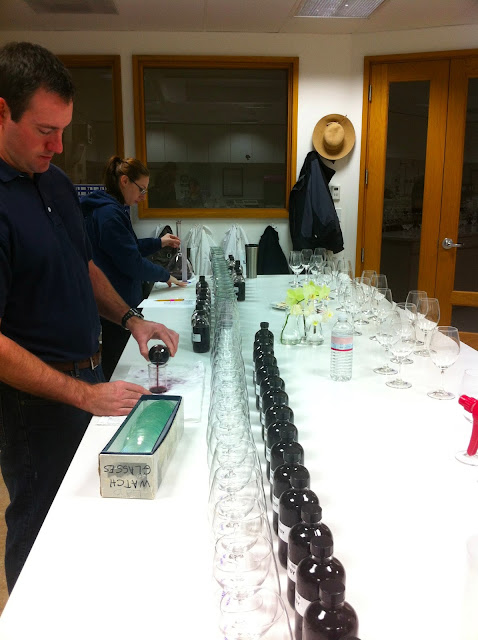I'm going to switch gears for a moment from my home winemaking adventures to what my lab has been up to all January. Blending!
The first step is to taste all the different lots from 2012, as seen here on the table. This is an insane amount of wine to process in a day, but it's part of the job. By the time January rolls around I am so out of practice it takes a while to get calibrated to tasting this much wine in a short period.
Actually, tasting this much wine is not the issue, the problem is having useful things to say about this much wine. After the first 20 I find myself just repeating the same descriptors, or writing down "red wine" on everything. After a few days though I'm able to once again find and define the nuances. And things go from being "fruity" to cherry or strawberry.
Each glass represents a different tank or lot that we fermented. The winemaking team tastes every glass and we rank the lots in order of quality and then see which are similar enough to combine so that we have a more manageable number to work with. It's only the first day that we have the table filled like this. We went from 67 and combined down to 38.
The next day we look at the 38 lots and from those make the best blend we can. A single blend. Which is a unique thing. In my previous winery we made 9 different wines and the one before that upwards of 15. However, making this one wine is a lot more intense than how we made the 9 at my previous winery. Very few places make only one wine.
We do this process 3 to 4 days a week, which requires a lot of preparation, set and and clean up, so I have a lot of help from my interns. Aaron is pouring the lots into the glasses and Gilroy is right behind him making a "Kitchen Sink" blend.
The Kitchen Sink Blend is so called because we put in everything. This gives us an idea of the entire vintage and is a good starting point. Sometimes we can use it as a guideline, if the KS has some bitterness or herbal characters we can try to find the individual lots and remove them from the blend.

Then over the next several days and weeks we begin making blends of the lots in different combinations and quantities. In this picture we are up to Blend 7. Last year it took us 32 blends before we decided on #33 as the final blend for 2011. As of this writing I have put together 11 Blends and we are still working on some for next week. But 2012 is an exceptionally delicious year, so I doubt it will take very many.
Here is the lab set up with each color being a station for a member of the winemaking team. This day we had 6 Blends to evaluate on one side of the lab bench and on the other side were 38 of the main lots for consideration. This is what the lab looks like almost every day in January, and February will look similar but the focus will be the 2011 vintage. We taste the blends, pick our favorite and then go to the other side to taste the individual lots to see what should stay in and what should be removed.
And this is what the lab looks like almost everyday at the end of the day. I am so grateful for my interns who help put this together everyday. Usually harvest interns start in August and leave by November or December but I'm keeping one until the end of this month and another until early March.
Let's hear it for Interns!
-L






Is Aaron behaving himself?
ReplyDeleteHahah. Aaron was a model intern! He's even house/dog sitting for me while I am gone. He's a full service intern :)
Delete